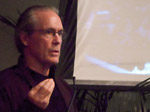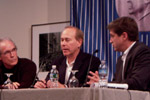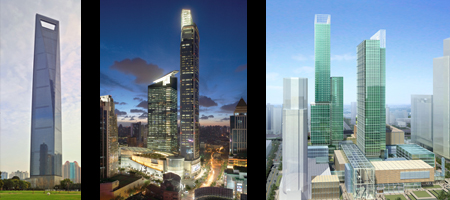The Skyscraper Museum is devoted to the study of high-rise building, past, present, and future. The Museum explores tall buildings as objects of design, products of technology, sites of construction, investments in real estate, and places of work and residence. This site will look better in a browser that supports web standards, but it is accessible to any browser or Internet device.
KPF in Shanghai:
Skyline and Streetscape
KPF in Shanghai:
Skyline and Streetscape
- Carol Willis, Introduction
- William Pedersen Design Partner, Kohn Pedersen Fox
- James von Klemperer FAIA, Principal, Kohn Pedersen Fox
- Panel Discussion
Video by koko for www.kokobaz.com
OCTOBER 27, 6:30 PMThe William and Anita Newman Vertical Campus, Baruch College
55 Lexington Avenue (at 24th Street): 14th Floor, Room 220
KPF in Shanghai
Skyline and Streetscape
1.5 CEUs available
 KPF founding partner, Bill Pedersen began the October 27th' program, "KPF in Shanghai: Skyline and Streetscape," with praise for the firm's enlightened client Minoru Mori, the Japanese developer whose Rappongi Hills KPF complex designed in Tokyo in 2003.
KPF founding partner, Bill Pedersen began the October 27th' program, "KPF in Shanghai: Skyline and Streetscape," with praise for the firm's enlightened client Minoru Mori, the Japanese developer whose Rappongi Hills KPF complex designed in Tokyo in 2003.
Mori developed the Shanghai World Financial Center for Lujiazui in Pudong. Pedersen illustrated the conceptual backing to the SWFC's form and development. The inventive structural system developed by Leslie E. Robertson, the "dean of structural engineers," brings the form from the heaviness of the ground to the lightness of the sky. Pedersen traced the design development from the critique of the circular void at the top to its final translation as a rectangular cut.
 Principal James von Klemperer explained the challenge faced in Puxi, across the Huangpu River from Pudong, where SWFC sits. Puxi's narrow roads and dense historical fabric has been modernized, retrofitted, and redeveloped to make room for high-rise buildings to fill in the cracks. Plaza 66 is the tallest building in Puxi and located on Nanjing Road West, the densest and most traveled commercial road in China. Taking cues from the street character, Plaza 66's space, form, and movement respond to the curvature of Nanjing Road and acts as a tributary off the street, through the building, and back out onto the street.
Principal James von Klemperer explained the challenge faced in Puxi, across the Huangpu River from Pudong, where SWFC sits. Puxi's narrow roads and dense historical fabric has been modernized, retrofitted, and redeveloped to make room for high-rise buildings to fill in the cracks. Plaza 66 is the tallest building in Puxi and located on Nanjing Road West, the densest and most traveled commercial road in China. Taking cues from the street character, Plaza 66's space, form, and movement respond to the curvature of Nanjing Road and acts as a tributary off the street, through the building, and back out onto the street.
Jamie also spoke about current projects, including Jing'An Kerry Center, modeled after Rockefeller Center in its mixed-use complex. In the context of this project, Jamie emphasized the responsibility of an architect to preserve something of the lilong blocks, because they give life to the city by giving room to public space. These observations informed The Skyscraper Museum's current exhibition, "China Prophecy," and the discussion between the speakers and Cliff Pearson of Architectural Record, who moderated the following panel discussion.
 Cliff spoke from experience when he reported the advancements and continually changing circumstances in designing and building in Shanghai and China in general. Cliff wrapped up the conversation in asking what New York or other American cities can be learned from Shanghai, which Bill Pedersen referenced the friendship between Mr. Mori and Mr. Larry Silverstein. Practice in China allows for risks and experimentation that, in Jamie's opinion, could inform planning and design in American cities, such as New York's Battery Park City.
Cliff spoke from experience when he reported the advancements and continually changing circumstances in designing and building in Shanghai and China in general. Cliff wrapped up the conversation in asking what New York or other American cities can be learned from Shanghai, which Bill Pedersen referenced the friendship between Mr. Mori and Mr. Larry Silverstein. Practice in China allows for risks and experimentation that, in Jamie's opinion, could inform planning and design in American cities, such as New York's Battery Park City.
Opened in August 2008, the 101-story SWFC currently crowns the Pudong skyline and ranks as the world's third tallest skyscraper. Other major projects in KPF's significant Shanghai portfolio will be illustrated in a survey by the firm's leading principals.

Left to Right: SWFC, Plaza 66 and Kerry Jing An Center
courtesy Jakob Montrasio and KPF


